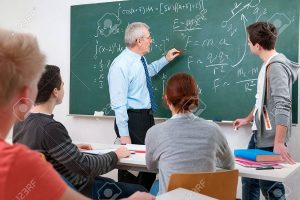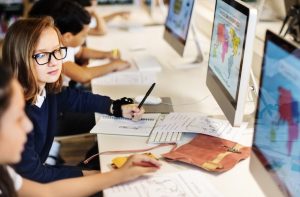The Math Lesson
Vocabulary
| term | A B C D F | come on (2) |
| sigh | pass back | turn around |
| proper | suppose | hand back |
| grade | in front | stand/stood/stood (2) |
| alright | research | speak/spoke/spoken |
| already | maker pen | for that matter |
| board | point (2) | make/made/made |
| reveal | represent | think/thought/thought |
| trick | figure (2) | kindergarten |
| silence | try/tried | term paper |
| equal | journal | write/wrote/written |
| stick | without | give us a break |
| follow | sign (2) | break/broke/broken (2) |
| source | stick-figure | stick/stuck/stuck (2) |
| draw/drew/drawn |


The Term Papers
Mr. Hunt handed back the term papers without saying a word.
“A ‘D’? How could I have gotten a ‘D’?” asked Rick. “This term paper is excellent!”
Sighs came from other students as they looked at the grades on their papers.
The Right Way
After he had passed back all the papers, Mr. Hunt stood in front of the class and spoke.
“Yes, most of you did turn in excellent papers. Too excellent. Alright, I’m going to show you how to write a term or research paper, or any type of writing for that matter.”
“But we already know how to write a term paper,” said Sally.
“Well, I’m going to show you the proper way.”
Math Formula
Mr. Hunt then turned to the white board. With a black, marker pen, he wrote “ 1 + 1 = “.
“Okay, what’s the answer to this?” he asked the class.
“Hey, I thought this was an English class, not mathematics,” said Peter.
“He thinks we’re in kindergarten,” voiced Barbara.
“Is this some kind of joke or trick?” asked Paul.
Then there was silence.
The Answer
“Okay, since no one knows the answer, I’ll reveal it,” said Mr. Hunt.
Following the equal sign, he wrote a “3“.
1 + 1 = 3
“Now we know who needs to be in kindergarten,” said Iris.
“Oh, but this IS true,” said Mr. Hunt.
“Oh, come on, Mr. Hunt. Give us a break,” said Steve.
“I’ll demonstrate to you.”
Shapes
Picking up a blue marker pen, Mr. Hunt drew a small circle under the first “1“, then colored it in. Next he drew a ball with the yellow marker under the second “1“. Then he turned around.
1 + 1 = 3
blue yellow
“So what’s the answer?”
Green
“It’s green!” answered Michael.
Mr. Hunt grinned, then drew a blue, yellow and green ball under the “3”.
“Okay here’s another one.”
Stick Figures
He now drew a stick-figure of a man under the blue ball under the first “1“; then a stick-figure of a woman under the yellow ball under the second “1“.
“Now what do we have?”
“A baby; a child!” said Susan.
Under the blue, yellow and green balls under the “3“, Mr. Hunt drew the stick figures of a man, woman and a little child.
Explanation
“Now what’s the point I’m trying to make?”
“If there are two things, two separate entities, two you can combine them to make something new . . . something different . . . something unique . . .” said Ruth.
“Exactly. Now look at this.”
Mr. Hunt pointed to the first “1“. “Okay, this is YOU.” Pointing to the second “1“, he told the class that it represented books, magazines, journals, newspapers, interviews and other sources of information.
“Now what do you suppose the “3” is?”
“It represents us, the information, and . . . our term papers!” answered Kathy.
“Properly written term papers,” Mr. Hunt clarified.


Questions
Numbers. Where does the story take place? Who is Mr. Hunt? Who are Kathy, Susan, Micheal, Iris, Paul, Barbara, Peter, Rick?
Arithmetic. Rick felt satisfied with his term paper, and very proud of himself. True or false? Why did he feel disappointed?
Addition, Subtraction. Did the students know how to write a proper term or research paper? Mr. Hunt said that the students’ term papers were “too” excellent. What did he mean by this?
Multiplication, Division. “I thought this was an English class, not mathematics.” What was Peter referring to?
Fractions, Percentages. Why did Mr. Hunt write the math formula on the board? What do the numbers represent?
Geometry. What analogies did he use?
Square meter, meters Cubed. What was Mr. Hunt’s point or message?
Triangle, Pyramid. Do you write term papers, research papers or reports in school, university, and, or at work? What topics do you write about?
Circle, Sphere, Hemisphere. How does or how can “1 + 1 = 3″ apply to your work and life?
Algebra. People nowadays have it much easier and better than people in the past. What do you think?
Trigonometry. What might happen in the future?
Statistics. What can or should schools, teachers, students, companies and individuals do?
